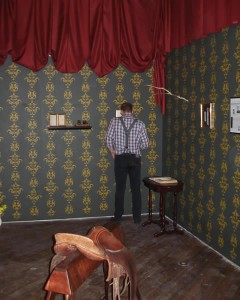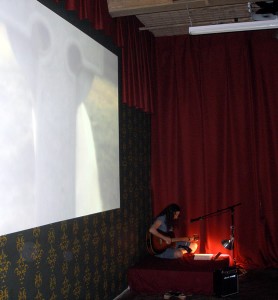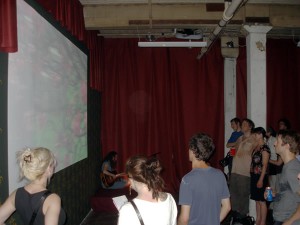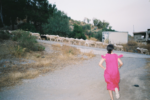On January 16, 1936 the Peekskill Evening Star newspaper ran two unrelated stories on the front page. One about a man being put to death in the electric chair, and the other about a wealthy man who had died; both were named Hamilton Fish. That is the germ of The Deaths of Hamilton Fish, an art installation, song cycle and film series created by Rachel Mason and now on display at Marginal Utility. Mason uses lighting and décor to create an eerie atmosphere that contains a sense of nostalgia and melancholy echoed in the songs and films about Hamilton Fish that play throughout the exhibit. But for those who have not heard the back story there may not be sufficient information to understand the complexity and depth of what Mason has created.

All of the elements of the show are drawn from the history of these men’s lives – both factually researched and fictionally elaborated by the artist. When I read the newspaper I too was struck by the ridiculous coincidence of the two stories running almost side-by-side. For two men with the same name to die on the same day is an oddity—but to have such an unusual name, and for one to be a descendant of one of the founding fathers (as Mason discovered in her research) and for the other to be a convicted murderer being executed in the electric chair sounds like a fictional parable. It begs for an explanation, a moral, or some kind of connection that makes this more than just a coincidence. Mason weaves a tenuous and elaborate connection through her films and songs.

The goal of the show is to create an environment in which every element has significance. Each component participates in Mason’s narrative either as inspiration or illustration. Still it is a lot to attempt for one artist—songwriting, filmmaking, performance and installation are all difficult disciplines and trying to create a whole in which they work together in balance is extremely ambitious. For me, the most successful component is the music. Song is a particularly emotional story-telling medium and Mason has crafted a series of ballads that reveal the Fish stories slowly and passionately. The songs and films play together as though a cross between opera and music video.

Where the show runs into difficulties is in the presentation of the art objects. The films play in a space decorated with hand-made wall paper and drapes that evoke a semi-historical context. A small number of objects that were used in the making of the films are also presented without labels or explanation. A saddle, bronze baby shoes, a dueling pistol, a dictionary and a stick—about eight items are strewn about in a largish space. Without a thorough understanding of the stories outlined in the songs and films there is no way for a viewer to connect these items to one another or to the newspaper stories that inspired it all. I spent a lot of time trying to puzzle out how each item fit into the show and being distracted by subtle anachronisms in the objects themselves. I’d prefer the show either without the objects or with wall tags to provide more information about how they connect to the overall story.
At the opening Rachel Mason performed the songs in sync with the films playing behind her. As much as I wanted to luxuriate in the music and mystery, I was put off by the extreme heat and to a lesser degree by the poor sound quality (so poor that they turned off one of only two fans in the room so she could be heard.) Granted most alternative spaces can’t afford much in the way of comforts, but it seemed as though the difficulties of the experience outweighed the draw for a lot of viewers. Mason has created something that could be poignant and captivating but it needs a different presentation—preferably one with chairs, speakers and air conditioning.










